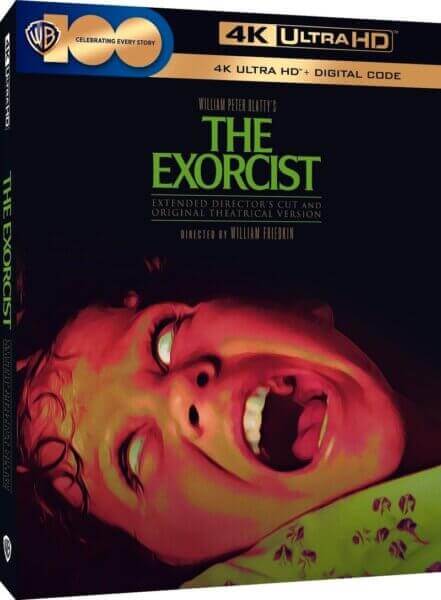On December 26, 1973, horror fans endured long lines for the theatrical premiere of The Exorcist – a film that’s now considered by many to be the scariest movie ever made. Directed by William Friedkin (The French Connection, The Boys in the Band) and based on the bestselling novel by William Peter Blatty, The Exorcist broke box office records in its first week of release. Theater employees reported that moviegoers were passing out, becoming ill, and heading for the exits before the credits rolled because the subject matter was so disturbing and intense.
The creation of the classic horror film, which is the gold standard for movies dealing with possession and the devil, begins with Blatty’s novel published in 1971. Blatty’s story focused on a 12-year-old girl named Regan MacNeil who went from a happy-go-lucky, horse-loving preteen to a foul-mouthed, head-spinning nightmare after being possessed by a demon. Coming to Regan’s rescue were two Catholic priests who eventually performed an exorcism to drive the evil entity out of the innocent child and back to Hell.
Blatty’s novel was (very loosely) based on the reported possession of 14-year-old Ronald Edwin Hunkeler (initially referred to as Roland Doe) in 1949.
Warner Bros. Pictures quickly purchased the rights to the bestselling novel following its release and eventually hired William Friedkin, hot off winning a Best Director Oscar for The French Connection, to direct. Blatty, who wrote the screenplay for the film, Friedkin, and the studio had different actresses in mind to play Regan’s mother, and names bandied about included Anne Bancroft, Jane Fonda, Shirley MacLaine, and Audrey Hepburn. Hepburn was interested but turned it down when filming couldn’t take place in Rome. Bancroft was also interested in the role but was pregnant at the time. The filming schedule precluded her involvement.
Actress Ellen Burstyn, best known for The Last Picture Show at the time, was certain the part was meant for her. After Friedkin met with Burstyn, he decided she was perfect to portray the strong, independent mother/actress Chris MacNeil. Burstyn’s take on the protective, yet terrified, mom earned her a Best Actress Oscar nomination.
For the role of Father Merrin, the elderly priest who had done battle with the Devil before, Friedkin picked 43-year-old Max von Sydow. The actor transformed from early-40s to 80 via three-hour makeup sessions.
Casting the part of Father Karras, the young priest who builds the case of possession and presents it to the church for authorization of an exorcism, was also a challenge. Father Karras’ struggle with his faith in God and his involvement in obtaining permission for an exorcism made for a juicy role, and Roy Scheider and Stacy Keach were both solid choices.
Keach was already signed for the part when, according to Friedkin’s memoir, he became convinced that playwright and stage actor Jason Miller (That Championship Season) was better suited. Miller had actually studied for the priesthood, which lent an authenticity to his performance. He earned a Best Supporting Actor Oscar nomination for playing the conflicted priest, but lost to John Houseman in The Paper Chase.
A thousand young girls auditioned for the part of Regan, which eventually went to New York child model Linda Blair. Friedkin paired up Ellen Burstyn and Linda Blair and confirmed they had the right mother-and-daughter chemistry. He also learned during the casting process that Blair’s performance was more compelling when she was allowed to change her lines on the spot.
Filming on The Exorcist began on August 14, 1972 and would last for an exhausting 200+ days. The stories of what it was like to be on the set and work with director William Friedkin are almost as legendary as the film itself. Among the war stories shared by those who experienced the filming were tales of Friedkin firing a pistol to shock the actors. There are even reports of Friedkin slapping William O’ Malley, a real priest who played Karras’ best friend Father Dyer, in the face to obtain the reaction he needed for a pivotal scene.
Some frightening – and unexplainable – incidents occurred during the shoot, leading to the rumor it was a cursed set. A set caught fire and burned to the ground, with only Regan’s bedroom left standing. The fire caused a six-week delay as the set was rebuilt. Ellen Burstyn was injured while shooting a scene in Regan’s bedroom, and numerous people associated with the film passed away during production.
The horrifying and unforgettable look of Linda Blair as the possessed Regan was created by makeup artist Dick Smith, who went on to earn a Best Makeup Oscar in 1985 for Amadeus. Smith created many different demonic looks for Regan, with Friedkin suggesting that her face should display bloody scars because of self-harm and still be recognizable as human. Smith’s said that working with Friedkin was tough but that it was also very stimulating. Collaborating with Friedman helped Smith do some of the best work of his career.
Friedkin had originally planned to use Linda Blair’s own voice and distort it, but ultimately decided to go another route. Radio actress Mercedes McCambridge was brought in to voice Pazuzu, with the actor spending hours in the sound booth and eating raw eggs, drinking alcohol, and smoking to get the desired sound – and personality – of the demon.
The exorcism scene required the actors’ breath to show, indicating the room was freezing. In an interview with DGA Quarterly Magazine, Friedkin described the process of bringing the temperature down.
“So, what we did was place a gigantic restaurant air conditioner across the top of the set. At the end of each day’s shooting, we turned on the A/C all night, so by the next morning it was 40 below zero. We also had to set little clip-lights on the floor and on the back of furniture. If you just had the actors talking and didn’t highlight their breath with lighting, it wasn’t going to show up on film,” said Friedkin.
Upon its release, the film set new box office records, and theaters were forced into adding extra showings to accommodate the never-ending lines of anxious moviegoers. Although The Exorcist received criticism for being too shocking and repulsive, the controversy surrounding the film didn’t keep audiences away. It also did not hurt the film’s critical reception, as the Academy of Motion Picture Arts and Sciences members recognized it with 10 Oscar nominations. The R-rated horror film won two Oscars: Best Sound and Best Adapted Screenplay.
The Exorcist forever changed horror movies and has the distinction of being the first film of its genre to receive a Best Picture nomination. In 2010, the Library of Congress added the film to the National Film Registry, an honor reserved for films that are considered culturally, historically, or aesthetically significant.
Additional reporting by Rebecca Murray.







